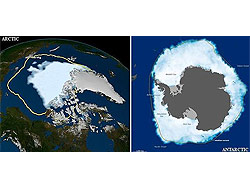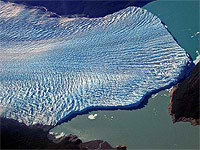Durante el Foro Internacional de Glaciología. "Cambios recientes en los glaciares de Latinoamérica" , explicó que sus volúmenes helados son vulnerables al presentar temperaturas que la mayor parte del año fluctúan entre menos 1 y menos 1.5 grados centígrados, en promedio.
En primavera y verano prácticamente llegan a los cero grados.
En el caso del Popocatépetl, abundó, existen tres razones por las cuales hay retrocesos importantes: el cambio climático que afecta a los glaciares del mundo, las condiciones ambientales locales con la presencia de la industria, y el hecho de ser un volcán en erupción.
Aunque el área glacial era pequeña prácticamente ya no existe. "Hay pedazos de hielo y en los últimos 15 años no ha habido acumulación, ya que los glaciares subsisten si cae nieve y se preserva, transformada" .
Según un comunicado de la Universidad Nacional Autónoma de México (UNAM) , el experto señaló que los que aún quedan están localizados en una extensión de 0.3 kilómetros cuadrados, pero no de manera continua, sino a manera de "parche pegado a la roca" .
Noticia completa en El Imparcial (México)
Enlaces a sitios |
| |
Climbing Magazine Climbing Magazine"s Web site contains more than 30 years of rock and ice climbing news, climber profiles, technical information, and gear reviews. You"ll also find message boards, photo galleries, and classifieds
| Cold Regions Bibliography Between 1999 and 2000, this project was carried out under an Interagency Agreement between the Federal Research Division of the Library of Congress and the U.S. Army Cold Regions Research and Engineering Laboratory (CRREL).
|
Descent into the Ice A tem of "glacionauts" ventures into a labyrinth of unexplored anda hazardous glacier caves on France"s Mont Blanc
| Glacier and Permafrost Hazards in Mountains – GAPHAZ Scientific Working Group of the International Association of Cryospheric Sciences (IACS) and the International Permafrost Association (IPA). Department of Geosciences University of Oslo
|
Glacier hazards The experience and data on glacier disasters in Switzerland has been systematically collected in the past two decades, and historical sources were analyzed.
| Glacier Hazards From Space Glacier hazards represent a continuous threat to human lives and infrastructure in mountain regions.
|
Glacier Hazards in Perú The floods, known in Perú as aluviónes, come with little or no warning and are composed of liquid mud that generally transports large rock boulders and blocks of ice.
| Glaciers and Glacier Hazards Glaciers and Glacier Hazards Glaciers and Ice Sheets and Volcanic Eruptions, USGS/Cascades Volcano Observatory, Vancouver, Washington
|
Glaciers online Glaciers online offers photos and summary explanations concerning glaciers from all over the world. The primary goal of our project is to enrich and stimulate the teaching of Earth Science and Physical Geography, in particular glaciology.. Jürg Alean & Mi
| Global Land Ice Measurements from Space GLIMS (Global Land Ice Measurements from Space) is a project designed to monitor the world"s glaciers primarily using data from optical satellite instruments, such as ASTER (Advanced Spaceborne Thermal Emission and reflection Radiometer).
|











 Imagen: Ecuador Ciencia
Imagen: Ecuador Ciencia





